Latest News
Aston Martin DBR 9 | Resolution 1600 x 1200
Posted by KC
on
Monday, September 21, 2009
, under
Aston Martin,
Aston Martin DBR9,
car wallpaper,
high resolution wallpaper,
race car,
resolution 1600x1200,
sport car
|
comments (0)
The Aston Martin DBR9 is a racing car by Aston Martin Racing, first built in 2005. The name DBR9 is derived from the original 24 Hours of Le Mans-winning DBR1 car, named for then-owner David Brown, which not only won the 24 Hour race in 1959 but also the World Sportscar title.
Based on the Aston Martin DB9 road car, the DBR9 retains the chassis, and the engine block and cylinder heads of the road car's V12 engine. The rest of the car is re-engineered for high performance competition use. The DBR9's bodywork is a blend of optimum aerodynamic performance and the styling of the DB9 road car. All the body panels are constructed from carbon fibre composite (except the roof) to minimize the weight of the car. To complete the aerodynamic body, the bottom of the car is flat all the way from the front to the rear diffuser. To optimise rear downforce a carbon fibre wing has been added. The car goes from 0-60 mph in 3.4 seconds.
For the 2007 24 Hours of Le Mans, Prodrive made modifications to the DBR9 design in order to not only improve performance, but also to increase driver comfort in the cockpit. Due to new regulations put into place by Le Mans organizers, the DBR9 required the installation of an air conditioning unit in order to prevent overstressing drivers. Prodrive went further by putting a heat-resistant white roof on all new cars to assist in keeping cockpit temperatures down. Performance modifications included the removal of two cooling vents from the bonnet of the car due to no longer being necessary.
Based on the Aston Martin DB9 road car, the DBR9 retains the chassis, and the engine block and cylinder heads of the road car's V12 engine. The rest of the car is re-engineered for high performance competition use. The DBR9's bodywork is a blend of optimum aerodynamic performance and the styling of the DB9 road car. All the body panels are constructed from carbon fibre composite (except the roof) to minimize the weight of the car. To complete the aerodynamic body, the bottom of the car is flat all the way from the front to the rear diffuser. To optimise rear downforce a carbon fibre wing has been added. The car goes from 0-60 mph in 3.4 seconds.
For the 2007 24 Hours of Le Mans, Prodrive made modifications to the DBR9 design in order to not only improve performance, but also to increase driver comfort in the cockpit. Due to new regulations put into place by Le Mans organizers, the DBR9 required the installation of an air conditioning unit in order to prevent overstressing drivers. Prodrive went further by putting a heat-resistant white roof on all new cars to assist in keeping cockpit temperatures down. Performance modifications included the removal of two cooling vents from the bonnet of the car due to no longer being necessary.


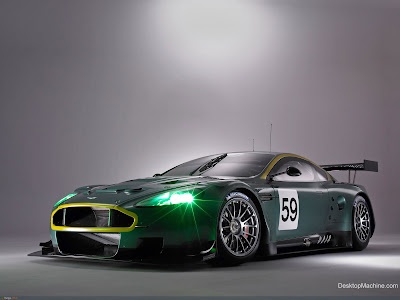




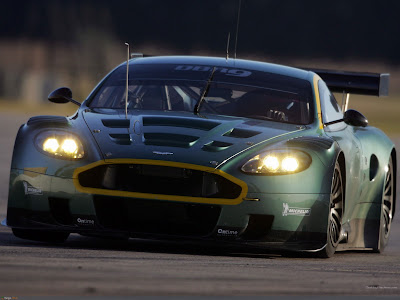





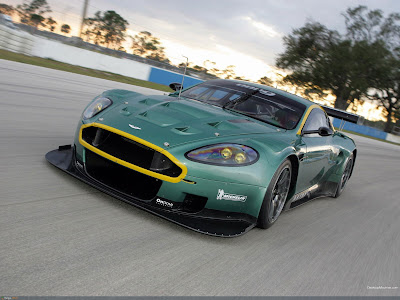





Watch Video of Aston Martin DBR9
Presented by Mega-Wall Blogger
2009 Ford GT Edo Competition | Resolution 1280 x 960
Posted by KC
on , under
car wallpaper,
Ford,
Ford GT Edo Competition,
high resolution wallpaper,
race car,
resolution 1280x960,
sport car
|
comments (0)
The Ford GT features many new and unique technologies, including super-plastic-formed aluminum body panels, roll-bonded floor panels, a friction-stir welded center tunnel, a “ship-in-a-bottle” gas tank, a capless fuel filler system, one-piece door panels and an aluminum engine cover with a one-piece carbon-fiber inner panel.
Brakes are four-piston aluminum Brembo calipers with cross-drilled and vented rotors at all four corners. When the rear canopy is opened, the rear suspension components and engine are visible.
The 5.4L Modular V8 powerplant is all-aluminum and fed by a Lysholm twin screw-type supercharger. It features a forged rotating assembly housed in an aluminum block designed specifically for the GT program. A dry sump oiling system is employed, allowing the engine to sit very low in the frame. The DOHC 4-valve heads are a revision of the 2000 Ford Mustang SVT Cobra R cylinder heads (with slightly increased wall casting thickness in the exhaust port). The camshafts have unique specifications, with more lift and duration than those found in the Shelby GT500 or 2003–2004 Ford Mustang SVT Cobra. Power output is 550 horsepower (410 kW) and 500 foot-pounds force (680 N·m) of torque. A Ricardo six-speed manual transmission is fitted featuring a helical limited-slip differential.
Performance:
* 0–60 mph (0–96 km/h): 3.3 seconds
* 0–100 mph (0–160 km/h): 7.4 seconds
* Standing 1/4 mile: 11.2 seconds @ 131.2 mph (211.1 km/h)
* Top speed: 205 mph (electronically limited)
The Ford GT is a mid-engined supercar. It was built by Ford Motor Company from 2003 to 2006. It began as a concept car designed in anticipation of Ford's centennial year and as part of its drive to showcase and revive its "heritage" names such as Mustang and Thunderbird. Camilo Pardo, the head of Ford's "Living Legends" studio, is credited as the chief designer of the GT and worked under the guidance of J Mays. The designers drew inspiration from Ford's classic GT40 race cars of the 1960s and the GT is sometimes mistaken for its 1960s counterpart.
Positive response on the auto show circuit in 2002 helped persuade the company to produce the car in limited quantities, and the first production versions appeared in 2005. It is a very high-performance, two-seater vehicle with a strong styling resemblance to its racing ancestor and performance to match. The powerplant is a mid-mounted supercharged 5.4 litre V8, producing 550 horsepower (410 kW) and 500 foot-pounds force (680 N·m). Top speed is 212 mph (341 km/h).
Brakes are four-piston aluminum Brembo calipers with cross-drilled and vented rotors at all four corners. When the rear canopy is opened, the rear suspension components and engine are visible.
The 5.4L Modular V8 powerplant is all-aluminum and fed by a Lysholm twin screw-type supercharger. It features a forged rotating assembly housed in an aluminum block designed specifically for the GT program. A dry sump oiling system is employed, allowing the engine to sit very low in the frame. The DOHC 4-valve heads are a revision of the 2000 Ford Mustang SVT Cobra R cylinder heads (with slightly increased wall casting thickness in the exhaust port). The camshafts have unique specifications, with more lift and duration than those found in the Shelby GT500 or 2003–2004 Ford Mustang SVT Cobra. Power output is 550 horsepower (410 kW) and 500 foot-pounds force (680 N·m) of torque. A Ricardo six-speed manual transmission is fitted featuring a helical limited-slip differential.
Performance:
* 0–60 mph (0–96 km/h): 3.3 seconds
* 0–100 mph (0–160 km/h): 7.4 seconds
* Standing 1/4 mile: 11.2 seconds @ 131.2 mph (211.1 km/h)
* Top speed: 205 mph (electronically limited)
The Ford GT is a mid-engined supercar. It was built by Ford Motor Company from 2003 to 2006. It began as a concept car designed in anticipation of Ford's centennial year and as part of its drive to showcase and revive its "heritage" names such as Mustang and Thunderbird. Camilo Pardo, the head of Ford's "Living Legends" studio, is credited as the chief designer of the GT and worked under the guidance of J Mays. The designers drew inspiration from Ford's classic GT40 race cars of the 1960s and the GT is sometimes mistaken for its 1960s counterpart.
Positive response on the auto show circuit in 2002 helped persuade the company to produce the car in limited quantities, and the first production versions appeared in 2005. It is a very high-performance, two-seater vehicle with a strong styling resemblance to its racing ancestor and performance to match. The powerplant is a mid-mounted supercharged 5.4 litre V8, producing 550 horsepower (410 kW) and 500 foot-pounds force (680 N·m). Top speed is 212 mph (341 km/h).





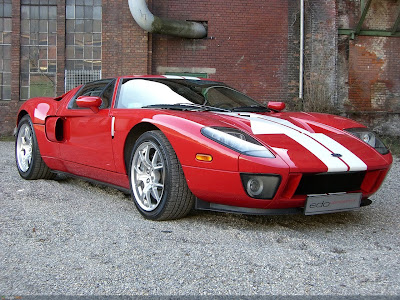








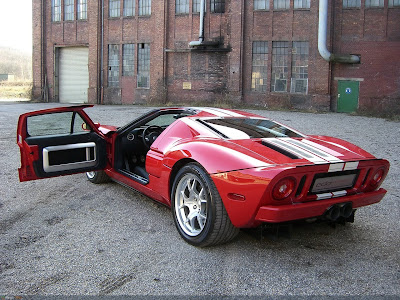


Presented by Mega-Wall Blogger
Koenigsegg CCX | Wallpaper Resolution 1920 x 1200
Posted by KC
on , under
car wallpaper,
high resolution wallpaper,
Koenigsegg,
Koenigsegg CCX,
race car,
resolution 1920x1200,
sport car
|
comments (0)
The Koenigsegg CCX is a mid-engined roadster from Swedish car manufacturer Koenigsegg. The CCX has been engineered to comply with the U.S. regulation and market demands and is an evolutionary design that replaced the Koenigsegg CCR. CCX is an abbreviation for Competition Coupe X; the X commemorating the 10th anniversary, (being the Roman numeral for ten), of the completion and test drive of the first CC vehicle in 1996. The CCX was first unveiled on February 28, 2006 at the 2006 Geneva Motor Show although its existence was announced earlier. A derivative known as the CCXR is available, the main difference being that CCXR's engine is tuned to run on biofuel. The different fuel and tune allows the CCXR to produce 25% more power than the CCX.
Performance
The CCX can accelerate from 0–62 mph (100 km/h) in 3.2 seconds and from 0–124 mph (200 km/h) in 9.8 seconds. According to Koenigsegg it has a top speed of 259 mph (417 km/h), although this has not been officially verified. On 15 June 2008, a standard fully equipped CCX was independently timed by sport auto in achieving a record 0-186-0 mph (0-300-0 km/h) in 29.2 seconds, beating out the Mercedes-Benz McLaren SLR 722 Edition, the Lamborghini Murciélago LP640, the Porsche 997 GT2, the Alpina B6 S (based on the BMW 6 Series), and the Corvette Z06.
Engine
While previous Koenigsegg models were powered by an engined based on the Ford Modular V8 engine sourced from the U.S., and modified by Koenigsegg, the engine of the CCX was designed by Koenigsegg themselves and is built ground up in the Koenigsegg factory. The Engine block is cast for them by Grainger & Worrall, a British company that produces drivetrain components for Formula One cars. The engine is a 4.7 liter 288 cu in (4,719 cc) V8, with dual overhead camshafts and 4 valves per cylinder. The engine block is made of 356 Aluminium that has undergone a T7 heat treatment, a form of accelerated precipitation strengthening. The aluminium alloy is stronger than the previous engine and allows a thinner, thus lighter, engine block that will withstand higher cylinder pressures. The engine is boosted by two centrifugal superchargers that provide 17.5 psi (121 kPa)of boost with an 8.2:1 compression ratio. The engine produces 806 bhp (601 kW; 817 PS) at 6900rpm and 678 lb·ft (919 N·m) of torque at 5700 rpm on 91 octane (U.S. rating) gasoline. The engine is lubricated with a dry sump system with a separate oil pump, the pistons are cooled by oil sprayed onto them and the oil itself has an external cooler. The CCX engine burns 17 L/100 km (17 mpg-imp; 14 mpg-US).
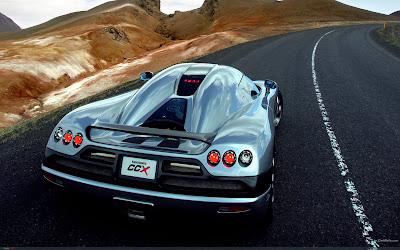


Presented by Mega-Wall Blogger

Performance
The CCX can accelerate from 0–62 mph (100 km/h) in 3.2 seconds and from 0–124 mph (200 km/h) in 9.8 seconds. According to Koenigsegg it has a top speed of 259 mph (417 km/h), although this has not been officially verified. On 15 June 2008, a standard fully equipped CCX was independently timed by sport auto in achieving a record 0-186-0 mph (0-300-0 km/h) in 29.2 seconds, beating out the Mercedes-Benz McLaren SLR 722 Edition, the Lamborghini Murciélago LP640, the Porsche 997 GT2, the Alpina B6 S (based on the BMW 6 Series), and the Corvette Z06.
Engine
While previous Koenigsegg models were powered by an engined based on the Ford Modular V8 engine sourced from the U.S., and modified by Koenigsegg, the engine of the CCX was designed by Koenigsegg themselves and is built ground up in the Koenigsegg factory. The Engine block is cast for them by Grainger & Worrall, a British company that produces drivetrain components for Formula One cars. The engine is a 4.7 liter 288 cu in (4,719 cc) V8, with dual overhead camshafts and 4 valves per cylinder. The engine block is made of 356 Aluminium that has undergone a T7 heat treatment, a form of accelerated precipitation strengthening. The aluminium alloy is stronger than the previous engine and allows a thinner, thus lighter, engine block that will withstand higher cylinder pressures. The engine is boosted by two centrifugal superchargers that provide 17.5 psi (121 kPa)of boost with an 8.2:1 compression ratio. The engine produces 806 bhp (601 kW; 817 PS) at 6900rpm and 678 lb·ft (919 N·m) of torque at 5700 rpm on 91 octane (U.S. rating) gasoline. The engine is lubricated with a dry sump system with a separate oil pump, the pistons are cooled by oil sprayed onto them and the oil itself has an external cooler. The CCX engine burns 17 L/100 km (17 mpg-imp; 14 mpg-US).



Presented by Mega-Wall Blogger





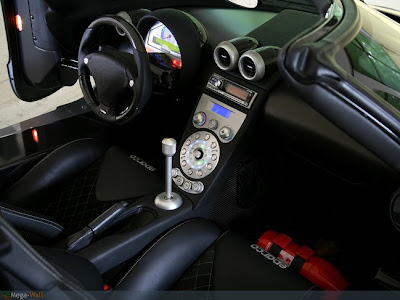







Presented by Mega-Wall Blogger

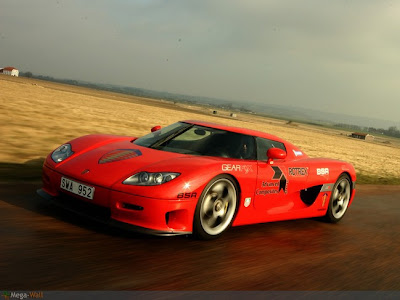
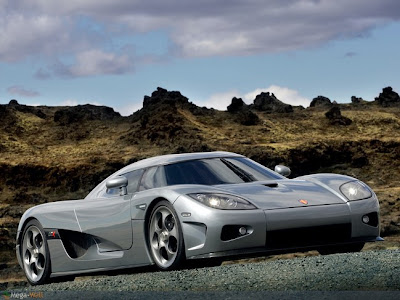







Presented by Mega-Wall Blogger
















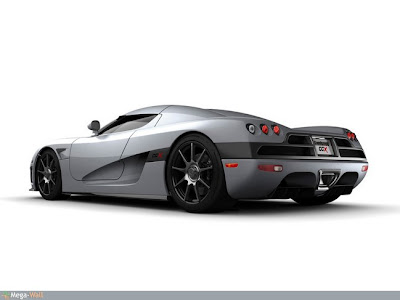
Presented by Mega-Wall Blogger






















